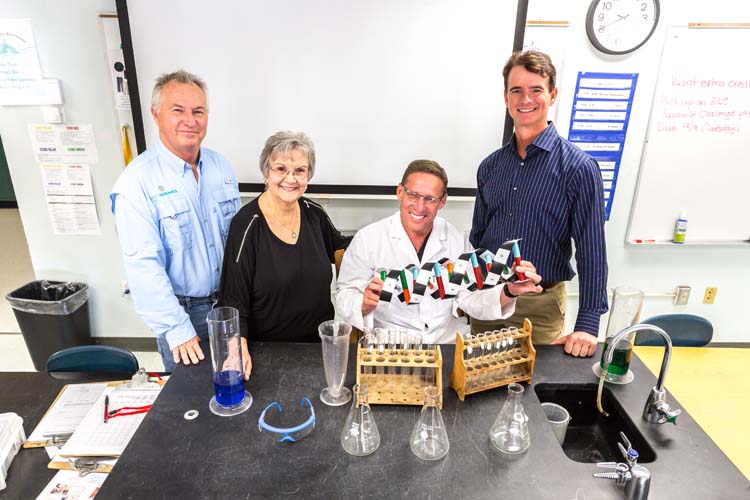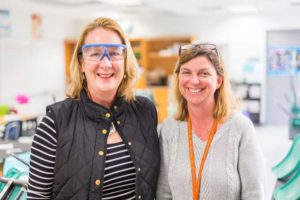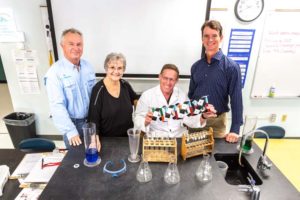
Each year, eager young minds delve into the unknown, working on projects ranging from animal and plant sciences to engineering and mathematics in hopes of being chosen to present their findings at the upcoming Indian River Regional Science and Engineering Fair, hosted by the Education Foundation of Indian River County in partnership with the School District.

Cynthia Falardeau and Lisa Presti
“We’re the only Education Foundation in the state of Florida that presents a regional science and engineering fair. So I tell everyone, therefore, ours is the best,” says Executive Director Cynthia Falardeau with a chuckle. “And truly, we have heard from other judges and even other families who have moved into the area, that our fair is unique because we have such tremendous community involvement.”
Falardeau explains that regional fairs elsewhere are often undertaken by just a few teachers and offer limited, if any, cash prizes or scholarships. The Indian River fair presents more than $1 million in prizes, thanks in large part to FIT college scholarships.
This year 220 secondary (6th to 12th grade) students and 320 elementary (K to 5th grade) students will compete in the IRC fair, whittled down from roughly 11,000 public, private and home-school students who competed in school-based fairs.
Equally impressive, about 130 people volunteer each year to be science fair judges, many returning year after year and often encouraging their friends to get involved as well.
“I think that’s how we are able to get such good judges. Because they have such a good time they invite their friends,” says Falardeau.
Among them is Scott Ferguson, a research scientist who has volunteered as a judge since the fair’s inception 26 years ago and who said he sees judging as a way to pay back all the great teachers who inspired him over the years. His daughters both participated and it clearly resonated. His eldest, Carly Ferguson Daniels, is now a senior scientist at Pfizer Pharmaceutical.
“It’s fun and it’s also reassuring to see the promising young minds; whether in chemistry, biology, math, physics, etc., there’s a lot of very bright young minds out there,” said Ferguson. “We’re in good hands.”
There are four teams of judges: place judges determine first-, second- and third-place winners; another team determines which 20 projects will be sent to the State Science & Engineering Fair of Florida; and a third team determines which project will be sent to the Intel International Science and Engineering Fair, the world’s largest. Additionally, colleges, universities and organizations send teams who choose recipients of their own prizes and scholarships.
Students set up their projects on Friday afternoon; giving judges a chance to preview them sans students. On Saturday morning, judges visit with students individually before meeting as a team to decide the rankings.

Scott Ferguson, Linda Clerch, S. James Schafer, and Ron Chesley
“The judges take their jobs very seriously. They spend a lot of time reviewing the project boards and reviewing the abstracts,” says Falardeau. “But what really levels the playing field is the presentation, and that’s what we stress. It’s not about how fancy the board is. It’s about ‘what did the child learn and what can they tell you.’ And it doesn’t mean that the experiment has to work. Some of the biggest mistakes, like the Post-it note, have become successes.”
Project categories are wide ranging: Animal Sciences, Behavioral & Social Sciences, Biomedical & Health Sciences, Cellular/Molecular Biology & Biochemistry, Chemistry, Earth & Environmental Sciences, Engineering, Environmental Engineering, Intelligent Machines, Robotics & Software Systems, Mathematics & Computational Sciences, Microbiology, Physics & Astronomy, and Plant Sciences.
There are still openings for judges. At the secondary level, they seek individuals with related experience or knowledge. Elementary judges need to be able to hear soft voices and understand just a little about the scientific method. Judges’ wheelchairs and scooters can be accommodated, but otherwise judges are on their feet all morning and there is quite a lot of walking.
To maintain the element of suspense and surprise, winners are never announced before the awards ceremony.
“As we announce the winner, their picture is projected on the screen and the crowd goes wild. It’s really truly exciting to see people jumping up and down for academics,” says Falardeau.
She notes that last year 100 percent of the students who went to the state competition took top awards.
Students have also advanced to the Broadcom MASTERS (Math, Applied Science, Technology and Engineering for Rising Stars), a competition for middle school students.
Falardeau says parents have related seeing their children progress from good students to great students and adds that participation also nurtures career success.
“That ability to be able to present and sell your ideas, complete a research project over a long period of time, complete forms and talk in front of people, it’s applied; learning. And it helps to make connections, especially with math. It encompasses all of the learning disciplines: reading, writing, math,” she explains.
“I love this program. It truly is a labor of love for us, for our board and for our judges. It’s the good news in education. The most rewarding part is when you see where it takes them. It’s so heartwarming and gratifying to see how the seeds we plant through the regional fair have helped them grow.”
The 26th annual fair takes place Saturday, Jan. 27, at Gifford Middle School. Public viewing for secondary projects is 11 a.m. to noon in the gym; elementary is 11:45 a.m. to 12:45 p.m. in the cafeteria. Awards Ceremonies at Sebastian River High School PAC are also open to the public: elementary is 3 p.m. Jan. 28, and secondary is 6 p.m. Feb. 1.
For more information, visit edfoundationirc.org.



